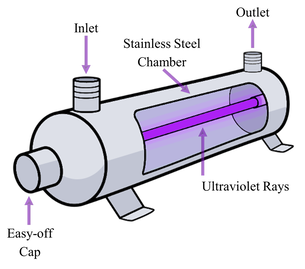Microbe Removal: How Ultraviolet Light Can HelpAbout Ultraviolet Light
Ultraviolet (UV) light utilizes radiation disrupting cellular DNA to kill microbes but is not utilized for removal of chemical contaminants. This treatment tool is generally used as a final step in reverse osmosis (RO) systems to improve the efficiency of microbe removal originating from the source water or that may grow in the POU system over time. All units require some level of routine maintenance, which may include cleaning and sanitizing and filter or light changes. In addition, some units require professional installation with associated labor fees. Inactivation on Hart-to-Control Organisms
A key advantage of UV light disinfection is that it can inactivate hard-to control organisms without chemical additions that can alter taste and does not produce harmful disinfection by-products (DBPs). However, this also means that no residual is produced, so there’s no post-treatment protection while the water passes through the distribution system. In addition, unlike conventional disinfectants, chemical water quality parameters, i.e., pH, temperature, alkalinity and total inorganic carbon, don’t impact UV efficacy. Treatment is completed in seconds in flow-through systems, eliminating the need for holding tanks and long contact times. Operating costs are relatively low compared to other conventional and alternative treatments. |
Certified Treatment Devices Click here to search for water treatment devices that have been certified to NSF/ANSI standards. Certification ensures that the device is made from safe materials and the contaminant reduction claims listed on the packaging are verified by independent lab testing. |
|
Benefits
|
Limitations
|
Other Resources
- 06/2002 Ultraviolet Lights: An Alternative Disinfectant [Link]
- 12/2011 Ultraviolet Light-Resistant Viruses Revealed [Link]
- 05/2015 Why a POU Device? [Link]
- Water Quality Association: Ultraviolet (UV) Light Fact Sheet [Link]
- EPA – Wastewater Technology Fact Sheet: Disinfection for Small Systems [Link]




